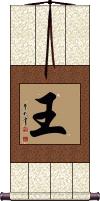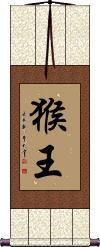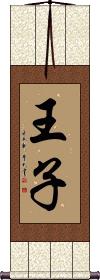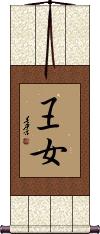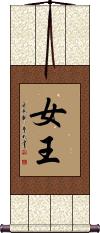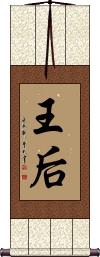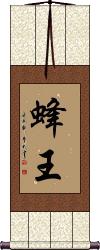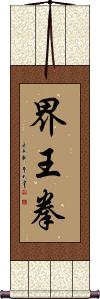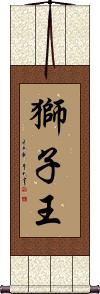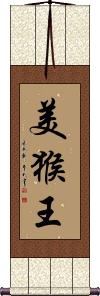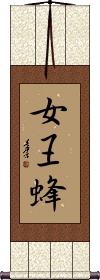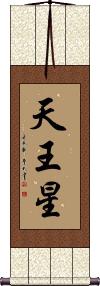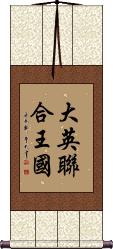Many custom options...
And formats...

王 in Chinese / Japanese...
Buy an 王 calligraphy wall scroll here!
Personalize your custom “王” project by clicking the button next to your favorite “王” title below...
1. King
2. Monkey King
3. Prince
4. Princess
5. Queen
7. Queen Bee
8. Kaio-Ken
9. Lion King
10. Monkey King
12. Pluto
13. Queen Bee
14. Uranus
15. Animal Kingdom
17. Lion Heart
18. Orchid Queen
19. United Kingdom
King
王 is wang which means king. It is not pronounced the way you think in Chinese. It is more like English speakers would want to pronounce wong. It has roughly the same vowel sound as tong, song, or long in English.
Note that this means king only, not the emperor. An emperor is higher than a king, and theoretically is chosen by God, according to ancient Chinese culture. However, the definition is often blurred at various points in Asian history.
王 can also be defined as ruler, sovereign, monarch, or magnate. It is also can refer to a game piece in the chess-like Japanese strategic game of shoji.
Note: This can also be a family name in Chinese, Korean and Vietnamese (in Vietnamese it's Vương).
Monkey King
猴王 is the short title for “Monkey King.” This can refer to the character made famous by the ancient novel Journey to the West.
This literally reads “Monkey King.” However, this title is open to interpretation and could be used for someone who is the boss of the primate exhibit at the zoo or certain characters in Chinese opera.
Prince
王子 is prince in Chinese characters and Japanese Kanji.
If you look at the meaning of each character, the first means king, and the second means son (or child). Thus, “King's Son,” “Son of the King,” or “King's Child” is the literal meaning of this title.
Princess
Queen
女王 is one way to write queen in Chinese, Japanese Kanji, and old Korean Hanja.
女王 is not the same thing as an empress.
The first character means “woman” or “female,” and the second means “king.” So this is literally “woman king.”
Queen / Empress
Wife of the King
王后 is another way to write queen in Chinese, Japanese Kanji, and old Korean Hanja.
王后 is sometimes used for the title of empress.
The first character means “king,” and the second means “wife,” or a short form to say “wife of the king/emperor.” So this is literally “king's wife” or “emperor's wife.” Some will translate this as “queen consort.”
Queen Bee
Kaio-Ken
Kaio-Ken
Lion King
Monkey King
The Planet Neptune
海王星 is the Japanese Kanji, old Korean Hanja, and Chinese title for the planet Neptune.
海王星 literally means “Sea God Star” (all planets end in the character that also means “star”).
Pluto
冥王星 is the Chinese, Japanese Kanji, and old Korean Hanja for Pluto (the dwarf planet or non-planet that used to be thought of as the 9th planet in the Solar system).
Queen Bee
Uranus
天王星 is the Chinese, Japanese Kanji, and old Korean Hanja for the planet Uranus.
Animal Kingdom
動物王國 is literally what it says.
There is even a TV show in China that is similar to Wild Kingdom or what you would currently see on the Discovery Channel that has this same title.
For your information: In the Chinese way of thinking, the Tiger is the king of the animal kingdom (lions are not native to China, so the tiger took the role that we have given to the lion in our western way of thinking).
The modern Japanese version has a slight variation on the last character (国 instead of 國). Let me know if you want the modern Japanese version (國 would be considered the old or traditional version).
Fudo Myo-o / Wisdom King
不動明王 is the fierce form of the Buddha Vairocana, and the most important of the Myō-ō or Ming Wang class of deities.
Romanized as Fudō Myō-ō, in Japanese Buddhism or Bùdòng Míngwáng / Pu-Tung Ming-Wang in Chinese Buddhism,
Originally Acala/Achala (अचल “The Immovable”), Acalanātha (अचलनाथ “Immovable Lord”) or Āryācalanātha (आर्याचलनाथ, “Noble Immovable Lord”).
In English, this deity is sometimes called “Wisdom King.”
Lion Heart
Orchid Queen
United Kingdom
United Kingdom
Not the results for 王 that you were looking for?
Below are some entries from our dictionary that may match your 王 search...
| Characters If shown, 2nd row is Simp. Chinese |
Pronunciation Romanization |
Simple Dictionary Definition |
王 see styles |
wàng wang4 wang ou / o おう |
More info & calligraphy: King(n,n-suf) (1) king; ruler; sovereign; monarch; (n,n-suf) (2) tycoon; magnate; champion; master; (n,n-suf) (3) (abbreviation) {shogi} (See 王将・おうしょう・1) king (of the senior player); (surname) Wan rāja, king, prince, royal; to rule. |
女王 see styles |
nǚ wáng nu:3 wang2 nü wang joou(p); jouou; nyoou / joo(p); joo; nyoo じょおう(P); じょうおう; にょおう |
More info & calligraphy: Queen(1) queen; (2) (じょおう, じょうおう only) female champion; (personal name) Joou |
猴王 see styles |
hóu wáng hou2 wang2 hou wang |
More info & calligraphy: Monkey King |
王后 see styles |
wáng hòu wang2 hou4 wang hou oukou / oko おうこう |
More info & calligraphy: Queen / Empressqueen |
王女 see styles |
wáng nǚ wang2 nv3 wang nü oujo(p); ounyo(ok) / ojo(p); onyo(ok) おうじょ(P); おうにょ(ok) |
More info & calligraphy: Princessprincess |
王子 see styles |
wáng zǐ wang2 zi3 wang tzu ouji / oji おうじ |
More info & calligraphy: Prince(1) prince; (2) subordinate Kumano shrine; (female given name) Kimiko prince |
蜂王 see styles |
fēng wáng feng1 wang2 feng wang |
More info & calligraphy: Queen Bee |
冥王星 see styles |
míng wáng xīng ming2 wang2 xing1 ming wang hsing meiousei / meose めいおうせい |
More info & calligraphy: Pluto{astron} Pluto (dwarf planet) |
天王星 see styles |
tiān wáng xīng tian1 wang2 xing1 t`ien wang hsing tien wang hsing tennousei(p); tenousei / tennose(p); tenose てんのうせい(P); てんおうせい |
More info & calligraphy: Uranus{astron} Uranus (planet) |
女王蜂 see styles |
jooubachi / joobachi じょおうばち |
More info & calligraphy: Queen Bee |
海王星 see styles |
hǎi wáng xīng hai3 wang2 xing1 hai wang hsing kaiousei / kaiose かいおうせい |
More info & calligraphy: The Planet Neptune{astron} Neptune (planet) |
不動明王 不动明王 see styles |
bù dòng míng wáng bu4 dong4 ming2 wang2 pu tung ming wang fudoumyouou / fudomyoo ふどうみょうおう |
More info & calligraphy: Fudo Myo-o / Wisdom King不動尊 Aryacalanatha 阿奢羅曩 tr. 不動尊 and 無動尊 and Acalaceta, 阿奢囉逝吒 tr. 不動使者. The mouthpiece or messenger, e. g. the Mercury, of the Buddhas; and the chief of the five Ming Wang. He is regarded as the third person in the Vairocana trinity. He has a fierce mien overawing all evil spirits. He is said to have attained to Buddhahood, but also still to retain his position with Vairocana. He has many descriptive titles, e. g. 無量力神通無動者; 不動忿怒王, etc. Five different verbal signs are given to him. He carries a sharp wisdom-sword, a noose, a thunder-bolt. The colour of his images is various—black, blue, purple. He has a youthful appearance; his hair falls over his left shoulder; he stands or sits on a rock; left eye closed; mouth shut, teeth gripping upper lip, wrinkled forehead, seven locks of hair, full-bodied, A second representation is with four faces and four arms, angry mien, protruding teeth, with fames around him. A third with necklaces. A fourth, red, seated on a rock, fames, trident, etc. There are other forms. He has fourteen distinguishing symbols, and many dharanis associated with the realm of fire, of saving those in distress, and of wisdom. He has two messengers 二童子 Kimkara 矜羯羅 and Cetaka 制吒迦, and, including these, a group of eight messengers 八大童子 each with image, symbol, word-sign, etc. Cf. 不動佛. |
連合王国 see styles |
rengououkoku / rengookoku れんごうおうこく |
More info & calligraphy: United Kingdom |
大英聯合王國 大英联合王国 see styles |
dà yīng lián hé wáng guó da4 ying1 lian2 he2 wang2 guo2 ta ying lien ho wang kuo |
More info & calligraphy: United Kingdom |
一王 see styles |
ichiou / ichio いちおう |
(given name) Ichiou |
万王 see styles |
mao まお |
(female given name) Mao |
三王 see styles |
mitsuo みつお |
(given name) Mitsuo |
丸王 see styles |
maruo まるお |
(surname) Maruo |
乙王 see styles |
otou / oto おとう |
(place-name) Otou |
九王 see styles |
kuou / kuo くおう |
(place-name) Kuou |
亀王 see styles |
kameou / kameo かめおう |
(place-name) Kameou |
事王 see styles |
shì wáng shi4 wang2 shih wang jiō |
service to the rulership |
二王 see styles |
èr wáng er4 wang2 erh wang niō におう |
the two guardian Deva kings The two guardian spirits represented on the temple gates, styled Vajrayakṣa 金剛夜叉 or 神 or 夜叉神. |
五王 see styles |
goou / goo ごおう |
(surname) Goou |
井王 see styles |
iou / io いおう |
(surname) Iou |
京王 see styles |
keiou / keo けいおう |
(place-name, surname) Keiou |
人王 see styles |
rén wáng ren2 wang2 jen wang ninnō |
Narêndra |
仁王 see styles |
rén wáng ren2 wang2 jen wang niwa にわ |
the two guardian Deva kings; (personal name) Niwa The benevolent king, Buddha; the name Śākya is intp. as 能仁 able in generosity. Also an ancient king, probably imaginary, of the 'sixteen countries' of India, for whom the Buddha is said to have dictated the 仁王經, a sutra with two principal translations into Chinese, the first by Kumārajīva styled 仁王般若經 or 佛說仁王般若波羅蜜經 without magical formulae, the second by Amogha (不空) styled 仁王護國般若波羅蜜經, etc., into which the magical formulae were introduced; these were for royal ceremonials to protect the country from all kinds of calamities and induce prosperity. |
倭王 see styles |
waou / wao わおう |
(archaism) king of Yamato |
僭王 see styles |
senou / seno せんおう |
usurper king |
Click here for more 王 results from our dictionary
The following table may be helpful for those studying Chinese or Japanese...
| Title | Characters | Romaji (Romanized Japanese) | Various forms of Romanized Chinese | |
| King | 王 | ou / o | wáng / wang2 / wang | |
| Monkey King | 猴王 | hóu wáng / hou2 wang2 / hou wang / houwang | ||
| Prince | 王子 | ou ji / ouji / o ji | wáng zǐ / wang2 zi3 / wang zi / wangzi | wang tzu / wangtzu |
| Princess | 王女 | oujo / ojo | ||
| Queen | 女王 | jo ou / joou / jo o | nǚ wáng / nv3 wang2 / nv wang / nvwang | nü wang / nüwang |
| Queen Empress | 王后 | ou kou / oukou / o ko | wáng hòu / wang2 hou4 / wang hou / wanghou | |
| Queen Bee | 蜂王 | fēng wáng feng1 wang2 feng wang fengwang | ||
| Kaio-Ken | 界王拳 | kai ou ken / kaiouken / kai o ken | jiè wáng quán jie4 wang2 quan2 jie wang quan jiewangquan | chieh wang ch`üan chiehwangchüan chieh wang chüan |
| Kaio-Ken | 界王拳 | kai ou ken / kaiouken / kai o ken | jiè wáng quán jie4 wang2 quan2 jie wang quan jiewangquan | chieh wang ch`üan chiehwangchüan chieh wang chüan |
| Lion King | 獅子王 狮子王 | shi shi ou / shishiou / shi shi o | shī zǐ wáng shi1 zi3 wang2 shi zi wang shiziwang | shih tzu wang shihtzuwang |
| Monkey King | 美猴王 | měi hóu wáng mei3 hou2 wang2 mei hou wang meihouwang | ||
| The Planet Neptune | 海王星 | kaiousei / kaiosei | hǎi wáng xīng hai3 wang2 xing1 hai wang xing haiwangxing | hai wang hsing haiwanghsing |
| Pluto | 冥王星 | mei ou sei / meiousei / mei o sei | míng wáng xīng ming2 wang2 xing1 ming wang xing mingwangxing | ming wang hsing mingwanghsing |
| Queen Bee | 女王蜂 | jooubachi / jobachi | ||
| Uranus | 天王星 | tennousei / tennosei | tiān wáng xīng tian1 wang2 xing1 tian wang xing tianwangxing | t`ien wang hsing tienwanghsing tien wang hsing |
| Animal Kingdom | 動物王國 动物王国 | doubutsu oukoku doubutsuoukoku dobutsu okoku | dòng wù wáng guó dong4 wu4 wang2 guo2 dong wu wang guo dongwuwangguo | tung wu wang kuo tungwuwangkuo |
| Fudo Myo-o Wisdom King | 不動明王 不动明王 | fu dou myou ou fudoumyouou fu do myo o | bù dòng míng wáng bu4 dong4 ming2 wang2 bu dong ming wang budongmingwang | pu tung ming wang putungmingwang |
| Lion Heart | 獅子心王 狮子心王 | shi shi shin ou shishishinou shi shi shin o | ||
| Orchid Queen | 蘭花女王 兰花女王 | lán huā nǚ wáng lan2 hua1 nv3 wang2 lan hua nv wang lanhuanvwang | lan hua nü wang lanhuanüwang |
|
| United Kingdom | 連合王國 連合王国 | rengououkoku / rengookoku rengokoku / rengokoku | ||
| United Kingdom | 大英聯合王國 大英联合王国 | dài yīng lián hé wáng guó dai4 ying1 lian2 he2 wang2 guo2 dai ying lian he wang guo daiyinglianhewangguo | tai ying lien ho wang kuo taiyinglienhowangkuo |
|
| In some entries above you will see that characters have different versions above and below a line. In these cases, the characters above the line are Traditional Chinese, while the ones below are Simplified Chinese. | ||||
Successful Chinese Character and Japanese Kanji calligraphy searches within the last few hours...
